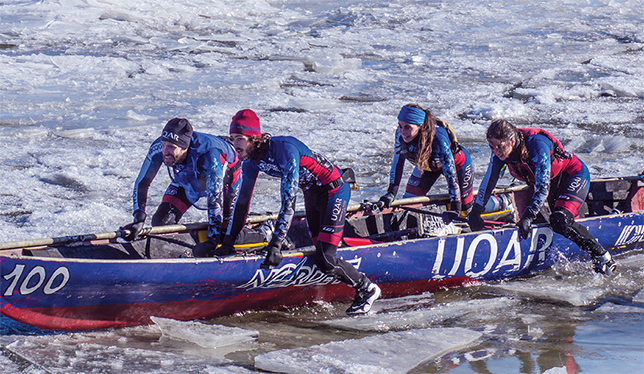Standing on the ice, one hand on his canoe, Dany Dumont, a professor in physical oceanography, surveys the water and waves before him. The researcher is studying the Ha! Ha! Bay and the St. Lawrence estuary near Rimouski in Quebec. With his students at the Institut des sciences de la mer de Rimouski (ISMER) at Université du Québec à Rimouski, he measures the thickness and roughness of the ice. They position sensors to record the amplitude of waves propagating through the pack ice, to find out how and under what conditions they manage to break up the ice.
To do this research, Dr. Dumont has formed an unusual partnership with the ice canoe team at UQAR, the only Canadian university to have two mixed-gender teams in the sport. The help enables him to travel safely to research sites across the open sea and on unstable pack ice. For the student athletes, it provides an additional opportunity to train and while serving science. “As far as I know, we are among the only scientific teams to use ice canoes for research,” says Dr. Dumont.
Ha! Ha! Bay and Bic National Park have thus become a laboratory for the study of the wave-ice interactions that characterize the Arctic and Antarctic, places where Dr. Dumont’s research would be far too expensive and practically impossible to conduct.
“At the poles, waves propagate through pack ice for dozens of kilometres. The impact is considerable,” he says. “The pack ice ripples and breaks up, becoming more vulnerable to heat exchange between the atmosphere and the ocean, which can speed up melting, especially against a background of a warming climate.”

The oceanographer and his colleagues are developing models that take these phenomena into account. “Within four or five years, we will be able to incorporate them into ocean weather forecasting models,” he notes. “They will then be useful for the safety of offshore oil operations and future Arctic navigation.”
For this year’s work, Dr. Dumont has made a point of acquiring his own canoe. Renaud McKinnon, a former canoeist with UQAR’s Nordet team, is helping the professor reconfigure the craft for research purposes.
“I’m thinking of using shorter oars and removing the middle seats so that I can install scientific equipment,” explains Mr. McKinnon, who will also train Dr. Dumont’s new students to use the vessel.
The collaboration between the scientist and the athletes is “raising the profile of ice canoeing in the region,” Mr. McKinnon says. Two of Dr. Dumont’s students got the bug this year and started training in the sport, and the researcher himself was awarded a prize at the 2015 Montreal Ice Canoe Challenge for his innovative use of a Canadian heritage icon. Will other researchers follow in his wake?